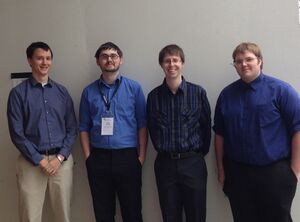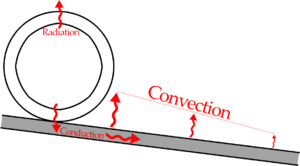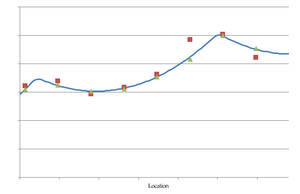Alternative Drain Pan Defrost
| Alternative Drain Pan Defrost | |
| Sponsor: | Colmac Coil |
| Team Name: | Thunder Coils |
| Duration: | Fall 2014 - Spring 2015 |
| Faculty Advisor: | |
| Mentor: |
|
| Students: | |
Creation and evaluation of a system that optimizes the spacing and cost of a heating method for preventing the buildup of ice in a drain pan for an evaporator in -30 F conditions.
Problem Definition
There are concerns that the current system design provides too much heating for the desired result, this is creating unnecessary costs and inefficiencies within that model. Our goal is to develop a better and more efficient method that not only satisfies the design requirements but also does not require the stocking of specialized parts that have little to no variability in design.
Cool air at or below freezing temperatures can condense frost on the drain pan, during a defrost cycle the pan is preheated to a desired temperature above freezing so that the ice-melt from the condenser does not refreeze upon hitting the drain pan and can quickly leave through a drain.
If this process is incomplete ice buildup occurs resulting in a solid block of ice that can no longer be melted in a typical defrost cycle. The other concern is when too much heat is being applied to the pan, this will result in turning some of the water into steam as well as introduces excess heat into the room that must be removed after the defrost cycle.
A major part of our goals is to find the ideal conditions that minimize excess heat to the room while preventing issues that occur from incomplete defrost.
There are currently two common methods and their known issues:
Hot Gas: Costs of pressure rated pipe and the installation is high, Borderline effective below -30 F
Electric Resistance Rods: Often provides substantially more heat than necessary, Most suppliers provide only predetermined shapes and dimensions
Our Goal was to:
Specifications:
Project Learning
Over the course of the semester we have learned about several alternatives that we will be perusing, during this semester we focused primarily on understanding and experimentation on the current design for a basis for quantitative measurement for the performance of not only their current system, but also analysis of the alternatives we will be evaluating.
For our heat transfer analysis we are utilizing real time collected data using a current logger and thermocouples as well as a thermal camera to provide upper and lower bounds to the transfer of heat using the following equations:
<math>Q_{upper}=I^2 R</math>
<math>Q_{lower}=Q_{conv}+Q_{cond}+Q_{rad}</math>
<math>Q_{conv}=h A (T_{(L)}-T_\infty)</math>
<math>Q_{cond}=k L (T_{(L)}-T_\infty)</math>
<math>Q_{rad}=\sigma (T_{(L)}^4-T_\infty ^4)</math>
Experimentation
We tested several designs: Heat Trace Cable, Heating mats, Heat Rods. Experimentation was carried out in the power lab using a variable voltage transformer.
Data was recorded using thermocouples and a data acquisition unit.
Modeling and Simulation
We used Engineering Equation Solver (EES) and Abaqus to predict optimal spacing and temperature distributions on the pan.
In EES, a transient 2D Node Method was derived for use.
Design Selection
In selection of the best design for our client we looked at a number of key factors including manufacturability, minimum temperatures at 5 minutes, material(s) cost, and durability.
Manufacturability was tested based on time to install on the test pan, for both first time install, and experienced. We also considered any tooling or special installation requirements as well as susceptibility to damage during installation.
Minimum temperature requirements were set by the client to reach an ideal temperature at 5 minutes to insure that all water exits the pan before the defrost cycle concludes. This is measured using thermocouples and a thermo-imaging camera and compared to modeling data to show the minimum temperature regions to insure that those location meet those requirements.
Team Information
| Anthony Gatlin |
| Mechanical Engineering |
| Hometown: Kennewick, Washington |
| Email: gatl2189@vandals.uidaho.edu |
| Jonathan Paul |
| Mechanical Engineering |
| Hometown: Stites, Idaho |
| Email: paul5935@vandals.uidaho.edu |
| Jamie Walker |
| Mechanical Engineering |
| Hometown: Post Falls, Idaho |
| Email: ----@vandals.uidaho.edu |
| Andrew Lake |
| Mechanical Engineering |
| Hometown: Post Falls, Idaho |
| Email: Lake5099@vandals.uidaho.edu |


